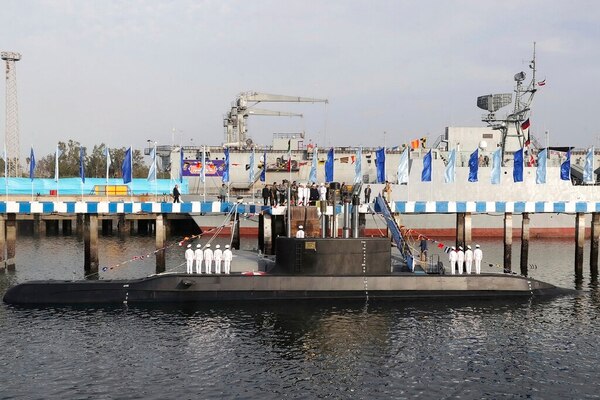
President Hassan Rouhani and other dignitaries attend the inauguration of Fateh, “Conqueror” in Persian, Iranian made semi-heavy submarine in the southern port of Bandar Abbas, Iran, in February. The Fateh has subsurface-to-surface missiles with a range of about 2,000 kilometers (1,250 miles), capable of reaching Israel and U.S. military bases in the region. (Iranian Presidency Office via AP)
Iran has developed a wide range of missiles, from the Shahab 1 ballistic missile, with a range of 300 kilometers, to the Soumar cruise missile with a reported range of 2,500 kilometersthat could strike targets anywhere in the Gulf, Israel, Egypt, Afghanistan, parts of southern and eastern Europe and elsewhere.
Late at night somewhere not far from the coast of Iran, U.S. sailors
sleep on board ship when suddenly a dull thud reverberates through the
hull and shocks them awake.
An Iranian mini-submarine or possibly a drone has wound its way through layers of defenses, struck the side of the warship and water is flooding in.
In the hours following the incident, Iranian leaders say it wasn’t an
intentional attack. Some of their naval personnel went rogue.
U.S. strikes on key missile defense positions along the Iranian coast
are already underway. Those strikes signal salvos for some a country
away, armed and ready to hit U.S. troops in short notice.
Near dawn at a dusty outpost along the Syria-Iraq border a handful of
U.S. Marines, soldiers and special operations forces are awakened to a
barrage of rockets and mortar fire like they’ve never seen on this or
any other recent deployment.
So far, a full-scale conflict between the U.S. and its allies and Iran and its proxies remains in the realm of wargaming at the moment. But with tensions rising between the U.S. and Iran, and as the U.S. moves more troops and military assets into the region, Pentagon planners and top U.S. intelligence officials have begun taking a closer look at what such a conflict might entail.
Iranian coastal defenses would likely render the entire Persian Gulf off limits to U.S. Navy warships. Iran’s advanced surface-to-air missile defenses would be a significant threat to U.S. pilots. And Iran’s arsenal of ballistic missiles and cruise missiles put U.S military installations across the U.S. Central Command region at risk. The cost in U.S. casualties could be high.
Beyond that, it’s unclear what victory might look like. Nobody is
advocating a large-scale occupation like the one that followed the 2003
U.S. invasion of Iraq. And many experts caution against hoping or
assuming that a massive U.S.-led military invasion will prompt Iranians
to overthrow their Islamic regime and transform Iran into an American
ally.
Iran’s military forces total roughly 545,000 active personnel and 350,000 reserve personnel, including about 125,000 men within the IRGC, according to the Strauss Center at the University of Texas, Austin. But while its total force strength is quite large, the quality is limited by an inability to purchase Western technology and severe economic sanctions.